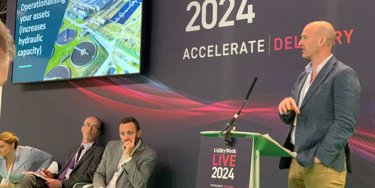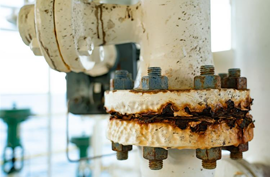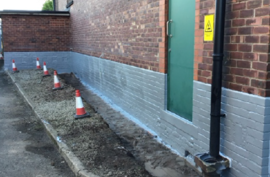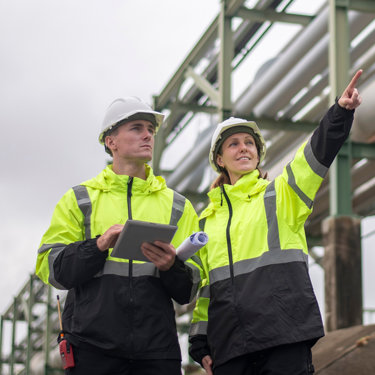Reducing the use and harm from storm overflows – a collaborative approach
Published: 24 May 2024
Managing Director of our water division, Mike Williamson, was at the NEC in Birmingham recently to speak at the Utility Week Live event on the ‘Reducing the use and harm from storm overflows in AMP8' panel alongside Anglian Water, Southern Water and Dŵr Cymru Welsh Water. The themes that emerged were optimising capacity, source control, innovation and collaboration, and the importance of monitoring and data.

A holistic approach
Mike spoke about ensuring your assets are operating at design capacity before investing in new infrastructure. He calls this 'operationalising your assets'. This involves a process of firstly locating your assets, then understanding an asset's design capacity, followed by testing to ensure they are operating to the required capacity.
There is almost always capacity in the existing network; it is a matter of locating and optimising it. By accessing the existing network capacity, we can do more with what we already have. Different water companies have different challenges. Groundwater, for example, can be a greater challenge in one region over another. Groundwater causes spills in dry weather conditions, so it needs to be considered when developing solutions.
All water companies agreed that a single strategy wouldn’t solve the problem, and a holistic, network-based approach was required. These could include source control, infrastructure optimisation, storm water treatment, alongside building bigger infrastructure.
Source control – slow the flow
Source control involves partnering with private homeowners and public locations like schools, hospitals, and highways to develop natural solutions to ‘slow the flow’. Installing natural soakaways and attenuation systems not only look attractive but are great examples of sustainable urban drainage.
Infiltration studies, like dye tracing, helps companies to understand where infiltration is an issue and is particularly relevant to areas where groundwater is a challenge. Sealing pipes with no-dig lining technologies, such as cured-in-place pipe (CIPP) lining and Compact Pipe, will reduce the flow and doesn’t require costly excavation.
Impermeable area studies is another tool that can be used. It is a way of finding how rainwater falling on impermeable areas such as roofs, roads, and driveways, enters the foul sewer network. This is different from infiltration studies but, when combined with other ‘slow the flow’ initiatives, it can be a great strategy for increasing capacity in the network.
Tackling misconnections to the foul sewer by working with construction companies and educating the public can reduce the unnecessary treatment of rainwater and surface water. According to 2019 data published by Defra, around 150,000 to 500,000 homes in the UK have drain misconnections.
Collaboration and innovation
As one speaker put it: “We can’t progress unless we all progress together.” A great sentiment which Mike reiterated.
We see lots of pilot projects happening in individual water companies with their own technology, such as those around Section 82. But where is the data from these pilots being shared? If one pilot is successful, surely another water company could build on the same technology, without starting their own unique trial elsewhere?
Regulatory constraints
This collaboration extends to regulators as well. There is a belief that outcome delivery incentives (ODIs) are misaligned with incentives for one challenge putting others at risk. A flexibility in permitting across catchments, recognising the uniqueness of each, would also be hugely beneficial.
Using capital for SaaS solutions causes financial constraints as water companies can’t spend Opex on it. Financial regulations currently feel like they are designed to send companies down the route of building new infrastructure, or at least having to purchase something that they can touch, when often it is the combination of a monitor, the data, and the software system that will provide the data needed to start really understanding what the problem is.
Other barriers cited include complex ownership throughout catchments with no rights or powers over much of the infrastructure, and the reluctance by regulators to approve wetlands.
Monitoring and data
Data – and being able to trust that data – was a huge theme to come out of the discussion. Monitoring CSOs is only scratching the surface. What about highways, housing, farmer run-off etc? Effective, accurate monitoring of rivers will provide vital evidence and inform the debate better. Millimetric measurement, being mandated in the requirement for all new and replacement CSO monitors fitted after April 2025 to be MCERTS certified, will tackle the accuracy of data from CSOs. But that leaves scores of other sources not monitored.
Mike referenced the need for the supply chain to step up as well, citing the lack of technology on the market to continuously monitor water quality up and downstream of CSOs for Section 82 legislation. “There is currently not one bit of kit that we know of, that could give data that would stand up in court when prosecuting or defending a spill.”
Generating accurate and appropriate data sources can allow for hydraulic modelling in the wastewater network. By monitoring mains, laterals, and gullies you can build a picture of your network, allowing AI models to inform where best to invest. One water company described trials of smart catchment control systems using flow data to create intelligent systems to control flow between pumping stations when used in combination with other natural solutions. The big question here is: how do you scale? It comes back to capacity. You need capacity in the network to deliver smart catchment control.
A strategic partner in your supply chain
AMP8 is set to see the largest ever investment in water sector assets, with £96bn quoted for water infrastructure and environmental protection strategies.
There are green shoots with promising pilots taking place nationally. We are ready to collaborate with you as part of your supply chain with end-to-end turnkey solutions for environmental consultancy, asset protection, and monitoring and data interpretation. We are innovating in areas of hydraulic modelling, monitoring (MCERTs and Section 82), CCTV investigation, and network remediation.
If you have a pilot project that you would like to collaborate on, find out more about our work with the water sector and get in touch.
More from our Knowledge Hub
 Insights
InsightsEarth Day 2025: Enabling a sustainable future while supporting today’s infrastructure in an evolving energy landscape
 Insights
InsightsMitigating climate change risks through planned preventive maintenance
 Insights
InsightsProtective coatings: Safeguarding infrastructure against climate change
 Insights
InsightsDelivering the Water (Special Measures) Act: Supporting compliance and innovation
Environmental compliance today, creating a sustainable tomorrow
Helping you reduce risk to the environment and your operation by managing assets compliantly while achieving commercial, ESG, and net-zero goals.
Contact our experts
